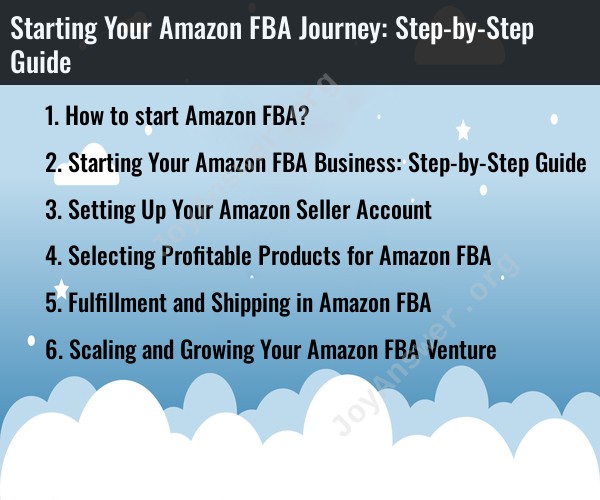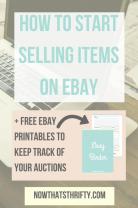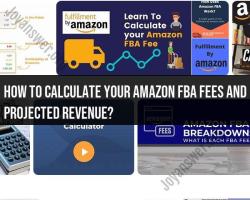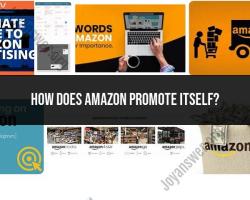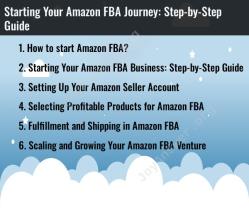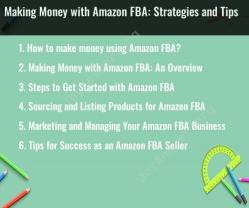How to start Amazon FBA?
Starting your journey with Amazon FBA (Fulfillment by Amazon) involves several steps to set up your online business, source products, and manage your inventory. Here's a step-by-step guide on how to get started with Amazon FBA:
Market Research and Product Selection:
- Begin by researching products that have demand on Amazon. Look for products with good sales potential and manageable competition. Use Amazon's best-sellers list, research tools like Jungle Scout, and consider your own interests and expertise.
Create an Amazon Seller Account:
- To use FBA, you need to create an Amazon Seller account. You can choose between an Individual Seller account (for low-volume sellers) or a Professional Seller account (for higher volume and access to more features).
Source Your Products:
- Find suppliers for the products you plan to sell. Common sourcing options include:
- Wholesale suppliers
- Private label manufacturers
- Retail arbitrage (buying from local retail stores)
- Online arbitrage (buying from online retailers)
- Dropshipping (using third-party suppliers)
- Find suppliers for the products you plan to sell. Common sourcing options include:
Set Up Your Amazon FBA Account:
- Within your Amazon Seller account, navigate to the "Fulfillment by Amazon" section. Follow the prompts to enroll in FBA and complete the required setup, such as providing your shipping and contact information.
List Your Products:
- Create product listings on Amazon for the items you plan to sell. Include high-quality images, compelling descriptions, and competitive pricing.
Prepare and Ship Inventory:
- Prepare your products for shipment to Amazon's fulfillment centers. This may involve labeling, packaging, and preparing shipments according to Amazon's guidelines. Amazon's FBA dashboard provides tools and guidance for this process.
Ship Inventory to Amazon:
- Create a shipment plan in your FBA account and arrange for your products to be shipped to Amazon's fulfillment centers. You can use Amazon's partnered carriers or choose your own.
Monitor Inventory and Sales:
- Keep track of your inventory levels and sales performance through your Amazon Seller account. You'll be able to see when stock is running low and restock as needed.
Customer Service and Feedback:
- Provide excellent customer service, respond to customer inquiries promptly, and handle any issues or returns professionally. Encourage customers to leave positive reviews.
Optimize Your Listings:
- Continuously optimize your product listings, including keywords, images, and pricing. Use Amazon's advertising tools (e.g., Amazon PPC) to promote your products.
Expand and Scale:
- As your business grows, consider adding more products to your inventory, expanding into new markets, or exploring other selling opportunities on Amazon.
Fulfillment and Shipping:
- Once your products are in Amazon's fulfillment centers, Amazon takes care of storage, packing, and shipping. You can monitor and manage your inventory through your FBA account.
Marketing and Promotion:
- Consider using Amazon marketing tools, social media advertising, and other marketing strategies to promote your products and drive traffic to your Amazon listings.
Compliance and Regulations:
- Be aware of and comply with Amazon's policies and guidelines, as well as any relevant legal and tax requirements for your business.
Fulfillment Fees and Costs:
- Understand the fees associated with FBA, including storage fees, fulfillment fees, and referral fees. Ensure your pricing strategy covers these costs and provides a profit margin.
Track and Analyze Performance:
- Regularly review your sales and performance metrics in your Amazon Seller account. This data can help you make informed decisions and adjustments to your business strategy.
Starting an Amazon FBA business requires careful planning, research, and ongoing management. It's essential to stay informed about changes in Amazon's policies and the e-commerce market, as these can impact your business. Success often comes with persistence, adaptability, and a commitment to providing value to customers.
Starting Your Amazon FBA Business: Step-by-Step Guide
Launching an Amazon FBA (Fulfillment by Amazon) business can be an exciting and rewarding endeavor, allowing you to reach a vast customer base and tap into the lucrative e-commerce market. Here's a step-by-step guide to help you get started:
1.1 Conduct Market Research and Identify Profitable Products:
Analyze market trends, customer demand, and competitor offerings to identify products with high sales potential and low competition.
Consider factors like product margins, shipping costs, and Amazon's fees to ensure profitability.
Choose products that align with your interests, knowledge, and ability to provide excellent customer service.
1.2 Create an Amazon Seller Account and Choose Your Selling Plan:
Register for an Amazon seller account, providing accurate business information and tax details.
Select an appropriate selling plan, either the Individual Plan for occasional sellers or the Professional Plan for high-volume sellers.
1.3 Source and Purchase Products from Reliable Suppliers:
Establish relationships with reliable suppliers who can provide high-quality products at competitive prices.
Negotiate favorable terms, including payment schedules, minimum order quantities, and shipping arrangements.
Ensure suppliers meet Amazon's product quality standards and delivery requirements.
1.4 Create Compelling Product Listings:
Craft clear, concise, and informative product descriptions that highlight the benefits and features of your products.
Use high-quality product images that accurately represent the products and showcase their details.
Utilize relevant keywords throughout the product listings to improve search visibility and attract buyers.
1.5 Set Competitive Prices and Manage Inventory:
Research market prices and competitor offerings to determine competitive pricing strategies.
Consider factors like product costs, Amazon's fees, and profit margins when setting prices.
Effectively manage inventory levels to avoid stockouts and excess storage fees.
1.6 Utilize Amazon FBA Fulfillment Services:
Enroll your products in Amazon's FBA program to streamline fulfillment and customer service.
Ship your products to Amazon's warehouses, where they will be stored, picked, packed, and shipped to customers.
Amazon will handle customer service inquiries, returns, and refunds, saving you time and resources.
1.7 Monitor Performance and Continuously Optimize:
Regularly track your sales, customer feedback, and profit margins to assess your business performance.
Identify areas for improvement and make adjustments to your product selection, pricing strategies, and marketing efforts.
Utilize Amazon's seller analytics tools to gain insights into customer behavior and competitor activity.
1.8 Expand Your Product Range and Market Reach:
Consider expanding your product range to increase sales and reach a wider audience.
Explore Amazon's international marketplaces to expand your customer base beyond your local market.
Utilize Amazon's advertising tools to promote your products and reach targeted customers.
1.9 Stay Informed and Adapt to Amazon's Policies:
Keep up-to-date with Amazon's policies, guidelines, and seller agreements to ensure compliance.
Adapt your business practices as Amazon's policies evolve to maintain a successful FBA venture.
1.10 Seek Guidance and Support from Experienced Sellers:
Connect with experienced Amazon FBA sellers through online forums, communities, and mentorship programs.
Learn from their experiences, seek advice on specific challenges, and gain insights into successful strategies.
Utilize available resources, such as Amazon's Seller University and webinars, to enhance your knowledge and skills.
Remember, building a thriving Amazon FBA business requires dedication, continuous learning, and a customer-centric approach. By following these steps and adapting to market trends, you can establish a successful online business and reach a vast audience of potential customers.
